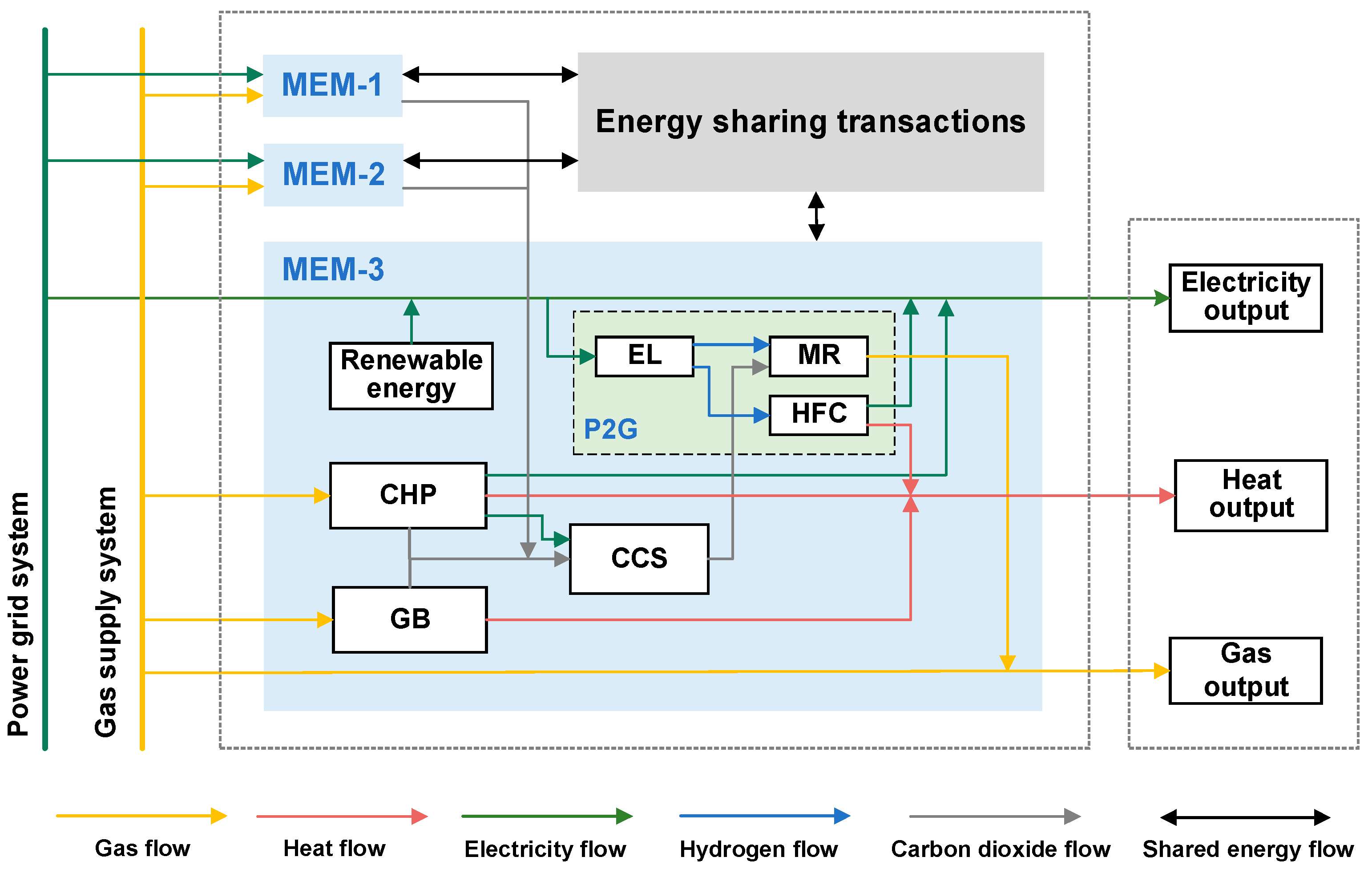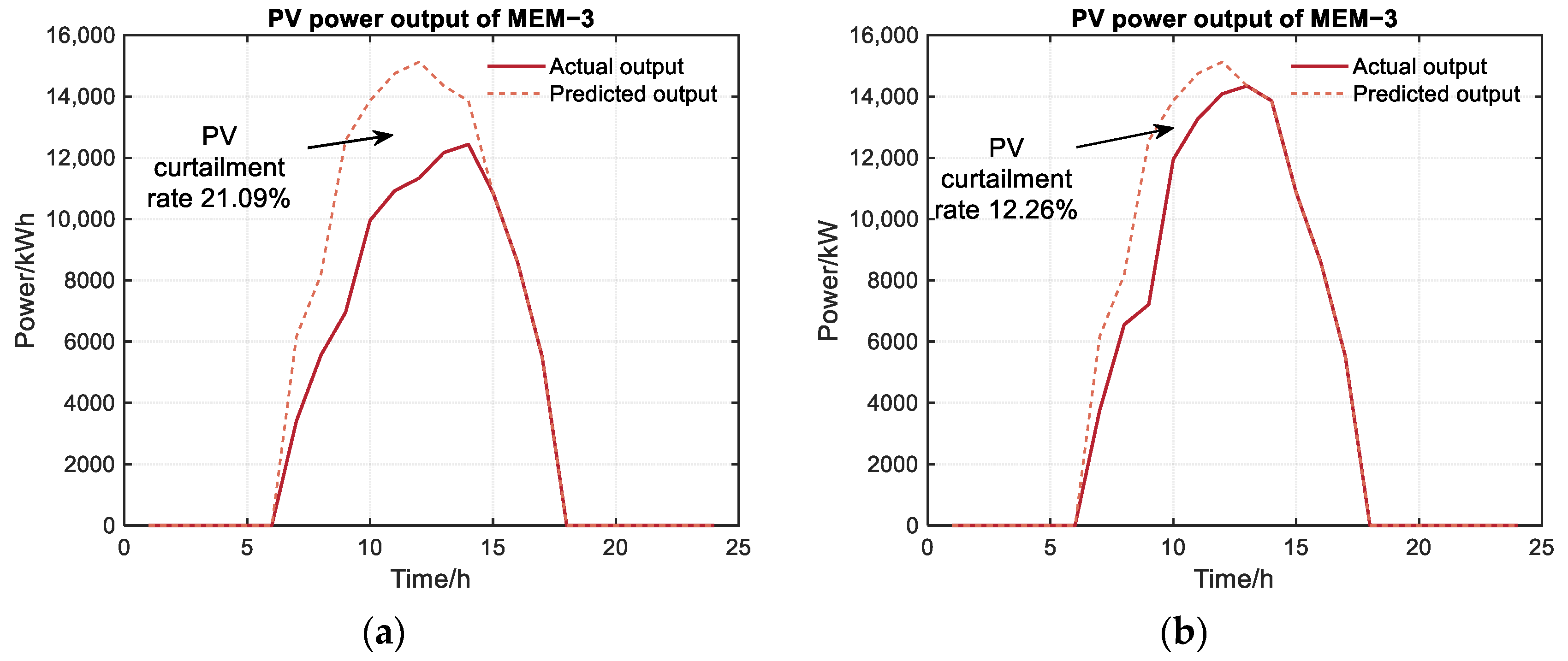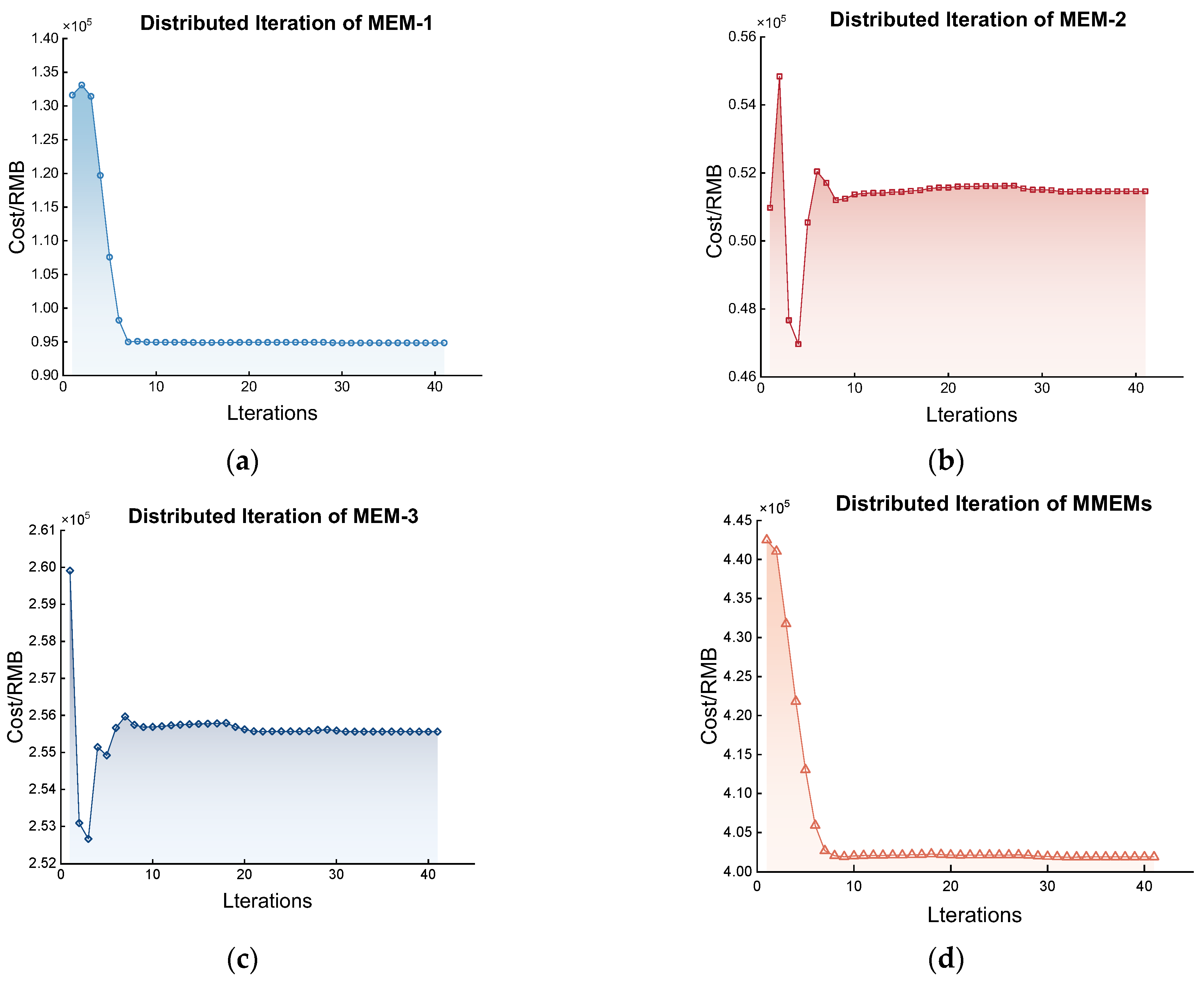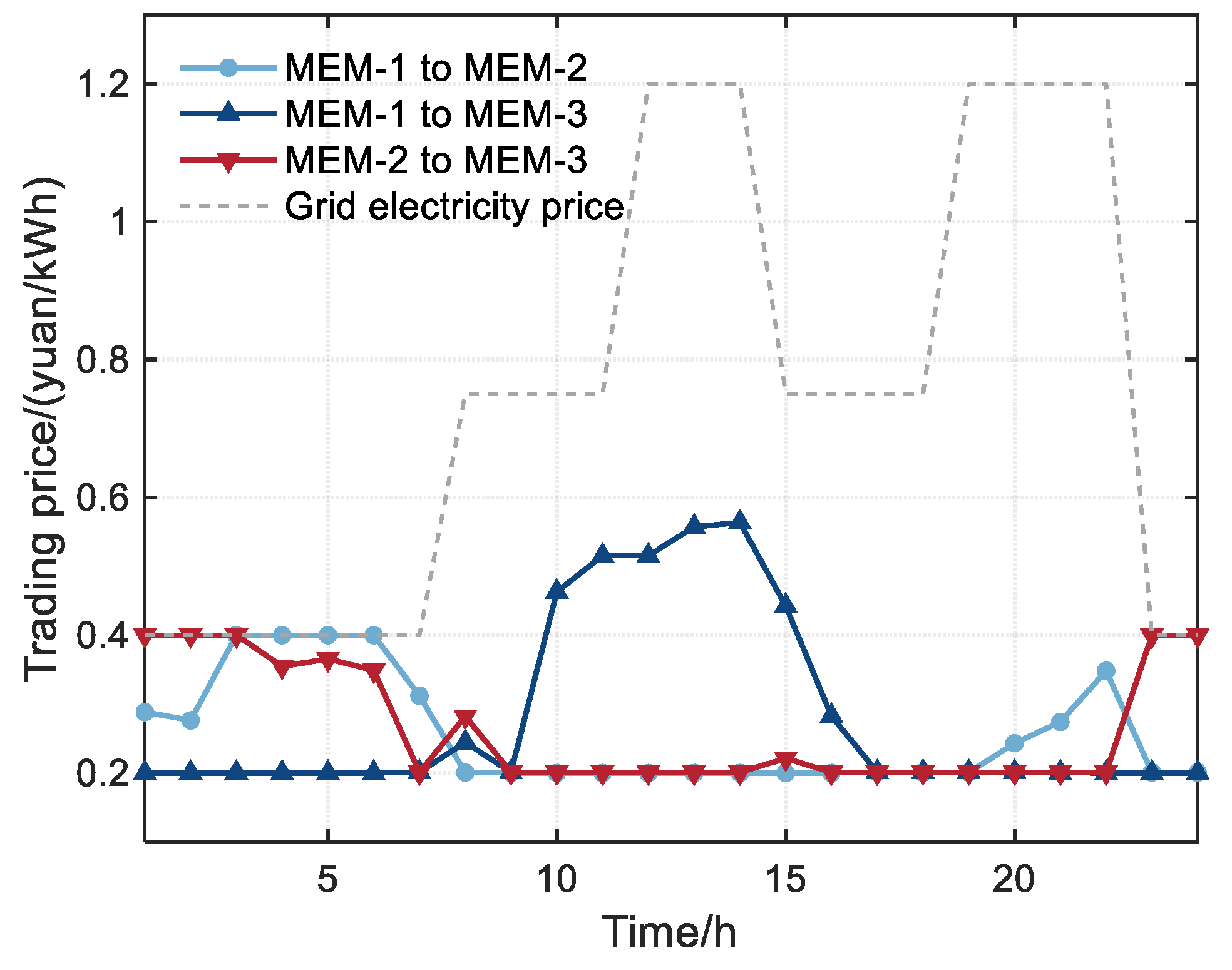Research on the Optimization of Energy–Carbon Co-Sharing Operation in Multiple Multi-Energy Microgrids Based on Nash Negotiation
Abstract
:1. Introduction
2. Energy–Carbon Co-Sharing Operation Model of Multiple Multi-Energy Microgrids
2.1. Subsection
2.2. Operation Model of Multiple Multi-Energy Microgrids
2.2.1. Operation Model of P2G
- Electrolyzer:
- Methane reactor:where is the natural gas power output by the MR of MEM-i at time t, is the hydrogen energy input to the MR of MEM-i at time t, is the energy conversion efficiency of the MR, and are the upper and lower limits of the hydrogen energy input to the MR of MEM-i, respectively, and and are the ramping rate constraints.
- Hydrogen fuel cells:where is the electrical energy output by the HFC of MEM-i at time t, is the thermal energy output by the HFC of MEM-i at time t, is the electrical conversion efficiency of the HFC, is the thermal conversion efficiency of the HFC, is the hydrogen energy input to the HFC of MEM-i at time t, and are the upper and lower limits of the hydrogen energy input to the HFC of MEM-i, respectively, and and are the ramping rate constraints.
2.2.2. Operation Model of the CHP
2.2.3. Operation Model of the GB
2.2.4. Operation Model of the CCS
2.2.5. Model of Electricity and Heat Load
2.2.6. Operation Model of Energy Storage Devices
3. Cost Model of Multiple Multi-Energy Microgrids
3.1. Objective Function
3.1.1. Cost of Buying and Selling Energy
3.1.2. Cost of Demand Response
3.1.3. Cost of Energy Storage Devices
3.1.4. Cost of Carbon Sharing
3.1.5. Cost of Carbon Trading
3.2. Constraints
4. Nash Negotiation Method Based on Cooperative Games
4.1. Sub-Model 1: The Model of Maximizing the Benefits of MMEM Alliances
- 1.
- Establish the augmented Lagrange function of the model (29):where is the Lagrange multiplier, and is a penalty parameter.
- 2.
- For each entity, update its own electricity trading strategy through calculation. MEM-j receives the amount of electricity, , which it expected to be purchased from MEM-i, and it updates its decision-making, . MEM-i accepts the updated decision-making information, , and updates its decision-making, ;
- 3.
- After completing a round of iterations, update the Lagrange multiplier and update the iteration number, :
- 4.
- Determine whether the algorithm converges according to Equation (33) and stop the iteration if it is satisfied, otherwise return to step (2) until it is satisfied.
4.2. Sub-Model 2: The Model of Income Distribution within the Alliance
5. Case Study
5.1. Basic Data
5.2. Results Analysis
5.2.1. Analysis of Energy Sharing Results
5.2.2. Analysis of Carbon Sharing and Carbon Emission Results
5.2.3. Analysis of Renewable Energy Consumption Results
5.2.4. Analysis of Renewable Energy Consumption Results
5.2.5. Analysis of Costs
6. Conclusions
- Energy–carbon co-sharing among MMEMs facilitates the complementary and efficient utilization of resources. Through the cooperative games, the renewable energy consumption was enhanced, resulting in increased renewable energy consumption rates of 8.34%, 8.78%, and 8.83% for MEM-1, MEM-2, and MEM-3, respectively.
- Energy–carbon co-sharing among MMEMs based on cooperative games can reduce the overall carbon emissions of MMEM alliances. The carbon emissions of each MEM in the case study were reduced to varying degrees, and the overall carbon emission reduction rate reached 17.81%, which proves that the energy–carbon co-sharing of MMEMs based on the Nash game is effective in reducing carbon emissions.
- The Nash-negotiation-solving algorithm of the MMEM alliance based on ADMM had good convergence, and the convergence accuracy reached 10−3 while also considering the privacy protection of each subject.
- The bargaining coefficient method based on energy–carbon co-sharing capacity is helpful in mobilizing the enthusiasm of all subjects to actively participate in the cooperative game. MEMs containing low-carbon units such as CCS and two-stage P2G units can achieve a fairer distribution of benefits compared to scenarios in which bargaining factors are not considered. Microgrids with higher renewable energy generation and more carbon capture can also obtain higher benefits in the energy–carbon co-sharing process.
Author Contributions
Funding
Data Availability Statement
Conflicts of Interest
References
- Ayele, G.T.; Mabrouk, M.T.; Haurant, P.; Laumert, B.; Lacarriere, B. Optimal heat and electric power flows in the presence of intermittent renewable source, heat storage and variable grid electricity tariff. Energy Convers. Manag. 2021, 243, 114430. [Google Scholar] [CrossRef]
- Fan, W.; Ju, L.; Tan, Z.; Li, X.; Zhang, A.; Li, X.; Wang, Y. Two-stage distributionally robust optimization model of integrated energy system group considering energy sharing and carbon transfer. Appl. Energy 2023, 331, 120426. [Google Scholar] [CrossRef]
- Liu, Y.; Zuo, K.; Liu, X.; Liu, J.; Kennedy, J. Dynamic pricing for decentralized energy trading in micro-grids. Appl. Energy 2018, 228, 689–699. [Google Scholar] [CrossRef] [Green Version]
- Ju, L.; Tan, Z.; Yuan, J.; Tan, Q.; Li, H.; Dong, F. A bi-level stochastic scheduling optimization model for a virtual power plant connected to a wind-photovoltaic-energy storage system considering the uncertainty and demand response. Appl. Energy 2016, 171, 184–199. [Google Scholar] [CrossRef] [Green Version]
- Ma, T.; Wu, J.; Hao, L. Energy flow modeling and optimal operation analysis of the micro energy grid based on energy hub. Energy Convers. Manag. 2017, 133, 292–306. [Google Scholar] [CrossRef]
- Zhang, F.; Yang, Z.; Zhang, L.; Xu, Z. Optimal operation of islanded micro energy grid with multi-type demand responses. Power Syst. Technol. 2019, 44, 547–557. [Google Scholar]
- Chiş, A.; Koivunen, V. Coalitional game-based cost optimization of energy portfolio in smart grid communities. IEEE Trans. Smart Grid 2017, 10, 1960–1970. [Google Scholar] [CrossRef] [Green Version]
- Liu, N.; Yu, X.; Wang, C.; Li, C.; Ma, L.; Lei, J. Energy-sharing model with price-based demand response for microgrids of peer-to-peer prosumers. IEEE Trans. Power Syst. 2017, 32, 3569–3583. [Google Scholar] [CrossRef]
- Wang, S.; Ping, C.; Xue, G. Synergic Optimization of community energy internet considering the shared energy storage. Electr. Power. 2018, 51, 77–84. [Google Scholar]
- Wang, X.; Liu, J.; Shen, W. Non-cooperative game trading model for shared energy storage based on blockchain. J. Nanjing Univ. Inf. Sci. Technol. 2022, 14, 595–603. [Google Scholar]
- Shuai, X.; Ma, Z.; Wang, X. Optimal operation of shared energy storage and integrated energy microgrid based on leader-follower game theory. Power Syst. Technol. 2023, 47, 679–690. [Google Scholar]
- Maharjan, S.; Zhu, Q.; Zhang, Y. Demand Response Management in the Smart Grid in a Large Population Regime. IEEE Trans. Smart Grid 2015, 7, 189–199. [Google Scholar] [CrossRef]
- Wei, F.; Jing, Z.; Wu, P.; Wu, Q. A Stackelberg game approach for multiple energies trading in integrated energy systems. Appl. Energy 2017, 200, 315–329. [Google Scholar] [CrossRef]
- Lin, K.; Wu, J.; Liu, D.; Li, D.; Gong, T. Energy management optimization of micro energy grid based on hierarchical Stackelberg game theory. Power Syst. Technol. 2019, 43, 973–983. [Google Scholar]
- Kim, H.; Lee, J.; Bahrami, S. Direct energy trading of microgrids in distribution energy market. IEEE Trans. Power Syst. 2019, 35, 639–651. [Google Scholar] [CrossRef]
- Xu, Y.; Liu, H.; Sun, S.; Mi, L. Bi-level optimal scheduling of multi-microgrid system considering demand response and shared energy storage. Elec. Power Autom. Equip. 2023, 43, 1–25. [Google Scholar]
- Wu, J.; Lou, P.; Guan, M.; Huang, Y.; Zhang, W.; Cao, Y. Operation optimization strategy of multi-microgrids energy sharing based on asymmetric Nash bargaining. Power Syst. Technol. 2022, 46, 2711–2723. [Google Scholar]
- Chen, J.; Hu, Z.; Chen, Y.; Chen, Y.; Chen, W.; Gao, M.; Lin, M.; Du, Y. Thermoelectric optimization of integrated energy system considering ladder-type carbon trading mechanism and electric hydrogen production. Elec. Power Autom. Equip. 2021, 41, 48–55. [Google Scholar]
- He, L.; Lu, Z.; Zhang, J. Low-carbon economic dispatch for electricity and natural gas systems considering carbon capture systems and power-to-gas. Appl. Energy 2018, 224, 357–370. [Google Scholar] [CrossRef]
- Jiang, C.; Ai, X. Integrated energy system operation optimization model considering uncertainty of multi-energy coupling units. Power Syst. Technol. 2019, 43, 2843–2854. [Google Scholar]
- Nash, J.F., Jr. The bargaining problem. Econometrica 1950, 18, 155–162. [Google Scholar] [CrossRef]
- Ma, T.; Pei, W.; Xiao, H.; Li, D.; Lv, X.; Hou, K. Cooperative operation method for wind-solar-hydrogen multi-agent energy system based on Nash bargaining theory. Proc. CSEE 2021, 41, 25–39+395. [Google Scholar]
- Stephen, B.; Neal, P.; Eric, C.; Borja, P.; Jonathan, E. Distributed Optimization and Statistical Learning via the Alternating Direction Method of Multipliers. Found. Trends Mach. Learn. 2010, 3, 1–122. [Google Scholar]
- Liu, Y.; Zhang, N.; Zhang, X. Economic operation of Wind-PV-ES hybrid microgrid by considering of energy storage operational cost. Modern Electr. Power 2013, 30, 13–18. [Google Scholar]













| Parameter | Value/kW | Parameter | Value |
|---|---|---|---|
| , | 0, 500 | 0.87 | |
| , | −250, 250 | 0.6 | |
| , | 0, 250 | , | 0.95, 2.1 |
| , | −125, 125 | , | 0.92, 2.1 |
| , | 0, 250 | 0.95 | |
| , | −125, 125 | , | 0.95, 0.96 |
| , | 0, 600 | 0.55 | |
| , | −1000, 1000 | 0.9 | |
| , | 0, 600 | 0.55 | |
| , | −1000, 1000 | 0.1 | |
| , | 500, 2500 | , | 1.08, 0.234 |
| , | 5000, 2000 | , | 0.5, 0.5 |
| 5000 | 0.01 |
| Carbon Emission Volume before Cooperation/kg | Carbon Emission Volume after Cooperation/kg | Carbon Emission Volume Reduction/% | |
|---|---|---|---|
| MEM-1 | 103,381 | 91,503 | 11.49% |
| MEM-2 | 123,808 | 86,533 | 30.11% |
| MEM-3 | 99,827 | 90,742 | 9.10% |
| MMEMs | 327,016 | 268,778 | 17.81% |
| Entities | Pre-Cooperation Costs/RMB * | Post-Cooperation Costs/RMB | Revenue Enhancement Value/RMB |
|---|---|---|---|
| MEM-1 | 104,604.82 | 94,851.47 | 9753.35 |
| MEM-2 | 78,344.45 | 51,462.24 | 26,882.21 |
| MEM-3 | 259,168.68 | 255,559.07 | 3609.61 |
| MMEMs | 442,117.95 | 401,872.78 | - |
| Entities | Bargaining Coefficient | Bargaining Proceeds/RMB | Cost after Revenue Distribution/RMB | The Value of the Yield Enhancement after Considering the Bargaining Factor/RMB |
|---|---|---|---|---|
| MEM-1 | 0.9172 | 2341.27 | 92,510.20 | 12,094.62 |
| MEM-2 | 0.8073 | −10,782.2 | 62,244.44 | 16,100.01 |
| MEM-3 | 1.2533 | 8437.39 | 247,121.68 | 12,047.00 |
Disclaimer/Publisher’s Note: The statements, opinions and data contained in all publications are solely those of the individual author(s) and contributor(s) and not of MDPI and/or the editor(s). MDPI and/or the editor(s) disclaim responsibility for any injury to people or property resulting from any ideas, methods, instructions or products referred to in the content. |
© 2023 by the authors. Licensee MDPI, Basel, Switzerland. This article is an open access article distributed under the terms and conditions of the Creative Commons Attribution (CC BY) license (https://creativecommons.org/licenses/by/4.0/).
Share and Cite
Yuan, X.; Cui, C.; Zhu, G.; Ma, H.; Cao, H. Research on the Optimization of Energy–Carbon Co-Sharing Operation in Multiple Multi-Energy Microgrids Based on Nash Negotiation. Energies 2023, 16, 5655. https://doi.org/10.3390/en16155655
Yuan X, Cui C, Zhu G, Ma H, Cao H. Research on the Optimization of Energy–Carbon Co-Sharing Operation in Multiple Multi-Energy Microgrids Based on Nash Negotiation. Energies. 2023; 16(15):5655. https://doi.org/10.3390/en16155655
Chicago/Turabian StyleYuan, Xiaoling, Can Cui, Guanxin Zhu, Hanqing Ma, and Hao Cao. 2023. "Research on the Optimization of Energy–Carbon Co-Sharing Operation in Multiple Multi-Energy Microgrids Based on Nash Negotiation" Energies 16, no. 15: 5655. https://doi.org/10.3390/en16155655





